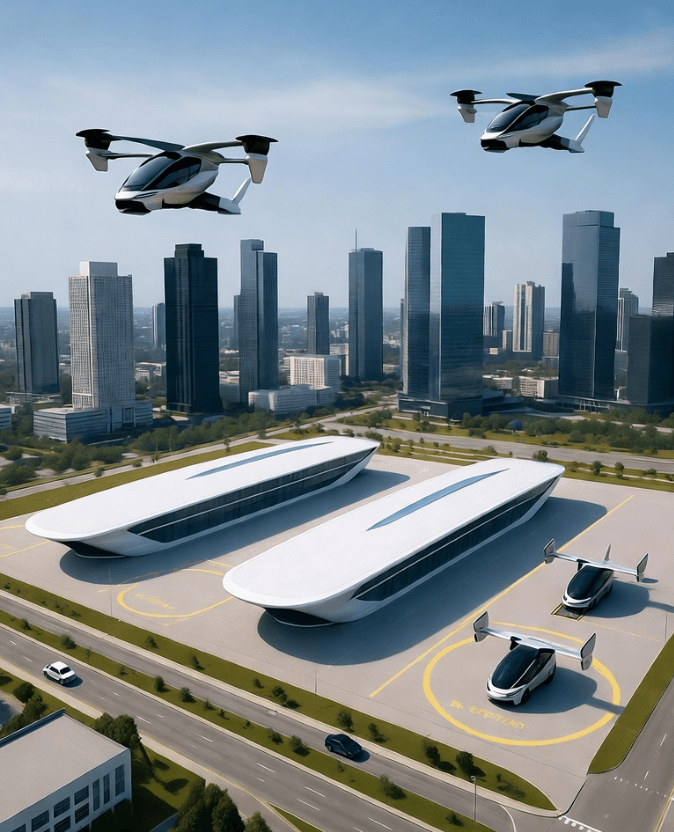Right now, the low-altitude economy is growing fast. This is because Urban Air Mobility (UAM) and Advanced Air Mobility (AAM) ideas are coming to life around the world. Recent industry reports, like the “Global AAM/UAM Market Map Update 2025,” confirm a big opportunity: 1,504 Vertiports (Vertical Take-Off and Landing Ports). These hubs are vital infrastructure for running electric Vertical Take-Off and Landing (eVTOL) aircraft and drones, making their safety and smooth operation key.
In these busy, automated vertiports, a single technology stands out as the core sensor for safety and good scheduling: Millimeter-Wave (mmWave) Radar. It has amazing performance, which helps keep the low-altitude air safe and allows for high-level automation.
I. Why Vertiports are Hard to Manage, and Why mmWave Radar Helps
Vertiports in cities face many hard problems. There are lots of take-offs and landings, complicated air currents from tall buildings, and a strict need to operate all the time, no matter the weather. Standard monitoring systems just cannot give reliable, high-precision data in all these situations.
Millimeter-Wave Radar, especially the advanced Frequency Modulated Continuous Wave (FMCW) kind, is the smart way to fix these issues.
1. Seeing Targets Clearly and Tracking Many at Once (MTT)
FMCW radar uses tiny frequency changes in a continuous wave to measure distance down to the centimeter level (sometimes even better). This means it can easily tell apart and follow many targets flying close together at different speeds. For example, in the vertiport’s main approach area, the radar can track three eVTOLs waiting to land, while also tracking a low-flying drone.
What the Experts Say: Reports from NASA show that vertiport monitoring systems must provide exact data on speed, distance, and angle. This is because the accurate data from FMCW radar is the basic information automated Air Traffic Management (ATM) systems need to plan take-offs and landings and avoid crashes.
2. Works in Any Weather, All the Time, and Uses Little Power
Millimeter waves (30 GHz to 300 GHz) can pass through rain, snow, and fog easily. The weather does not affect the radar much. This is important because even when visibility is zero (for blind landings), the vertiport can still give reliable navigation and tracking data.
Also, mmWave radar modules (such as those developed by Linpowave) draw little power and are designed for continuous operation. For example, you can learn more about Linpowave’s product range on their official website. Ningbo Linpowave+1
II. How Technology Works Together: Creating a Smart Monitoring Network
New vertiport systems need backup plans and smart features. mmWave radar is the main sensor. It uses AI and other sensors to improve automation and better identify threats.
1. AI Inside: Spotting Threats in Real-Time
When a vertiport is busy, the radar creates huge amounts of data. mmWave radar with AI Edge Computing can do a few things:
-
Telling Things Apart: AI uses information like the size and speed of objects (Radar Cross-Section, RCS) to immediately know the difference between an eVTOL, a small drone (UAS), a bird, or even Foreign Object Debris (FOD). This stops false alarms and starts the right safety steps.
-
Planning Ahead: The system constantly checks the runway and parking spots. It can guess when a conflict might happen. This lets it manage traffic automatically (High-Level Automation, HLA).
2. Mixing Sensors: Having a Backup Plan
To be totally safe, mmWave radar acts as the main location finder. It takes data from other systems like this:
-
LiDAR (Laser Radar): Gives extremely detailed 3D maps of the ground and nearby objects.
-
Cameras (Optical/Infrared): Used to confirm what an object is and get visual details.
-
MLAT (Multilateration) / ADS-B: Receives information about the aircraft’s ID and plan.
By mixing all this data, the radar covers for the cameras when the weather is bad. The result is a vertiport monitoring network that has full coverage, many backups, and is very trustworthy.
III. What Drives the Market and What’s Next for Low-Altitude Flying
The market data clearly shows mmWave radar’s important role in AAM infrastructure. Recent reports say the mmWave radar market is expected to grow strongly. For example, one report states the global mmWave radar market size was USD 1.68 billion in 2025 and is set to show a CAGR of 15.3 % through 2035. Ningbo Linpowave+1
Building safe, standard vertiport infrastructure is the first step for AAM to grow globally. mmWave radar gives a standard solution that works reliably in different weather and rule systems.
We can expect mmWave radar to stay the “safety watcher” as eVTOL flights become more common. Vertiports will move from being just ideas to real transport hubs secured by advanced sensors. This technology will help the worldwide AAM market reach its goal of USD 5.379 billion by 2032.
FAQ
Q1: Why can’t vertiports just use cameras or LiDAR to watch things?
A1: Cameras and LiDAR stop working well in bad weather or darkness. Cameras need light. LiDAR has trouble with rain or dust. Because of this, mmWave radar is needed. It works well and gives accurate data no matter the weather, making sure things stay safe all the time.
Q2: Why is FMCW radar better than older pulsed radar?
A2: FMCW radar is better mainly because it has very high distance resolution and uses less power. It can see objects only centimeters apart. This is important for a busy vertiport where things are close together. Plus, its design uses less power, which is good for systems running constantly.
Q3: How does the vertiport’s radar help eVTOLs land by themselves?
A3: The radar gives eVTOLs exact flight information. It tells the aircraft about the landing area’s current status (like wind changes or objects on the pad). This reliable data is used by the flight computer, helping the eVTOL land safely and precisely, even when pilots cannot see well or when the process is fully automated.
Q4: How much will the mmWave radar market grow in AAM?
A4: Market predictions are very good. mmWave radar is key to making vertiports smart and safe in all weather. Therefore, the market size is expected to increase a lot. Industry experts think the market will keep growing strongly, helping the worldwide AAM market reach USD 5.379 billion by 2032.



